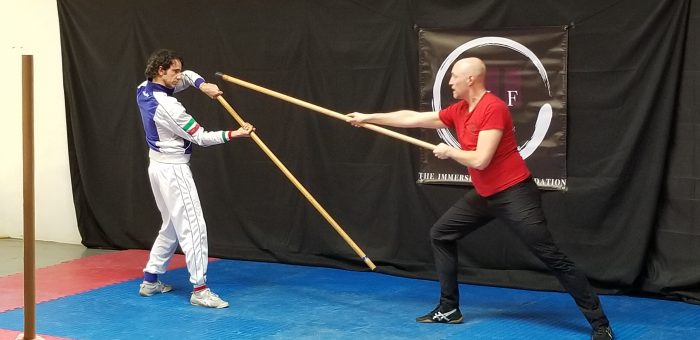I had the pleasure of attending an event last week called Stickmata put on by Immersion Labs in San Jose, California. The goal of this event (and similar past and upcoming events put on by Immersion Labs) is to bring together martial artists from diverse cultures and traditions. In this case everything was unified by one of humanity's oldest weapon: the stick.
I was there to teach European long staff (from Italian and English origins) and was among a diverse group of very accomplished instructors of Filipino stick, Japanese short and long staff, South American stick arts, Barbadian stick licking, Russian systema, Portoguese long staff, and Italian stick.
For me so much of the opportunity was getting to connect with these excellent instructors from diverse backgrounds to compare and contrast our arts and the ways that we teach them. It was also a useful occasion to truly define individual traditions and understand these arts as very specific disciplines passed down from a particular teacher through a particular line of students.
HEMA and Other Martial Arts
It was interesting being identified as the Historical European Martial Arts (HEMA) practitioner among the group, even though there were at least 2 others representing European traditions (Pedro Silva and Oscar from Portugal, and Marco Quarta and his students representing Italian stick from the Nova Scrimia tradition). HEMA has come to be very strongly associated with sword, and to a degree tournaments.
The term HEMA itself is a blanket term nearly as broad as "Martial Arts". Often it is used as if describing a single approach, or a single art. At this event, frequently a group introduction might sound like this "This is Paul he does Inosanto style, Philip does Stick Licking from Barbados, and Devon teaches 'hee-ma'."
Being able to represent something other than swordplay created an important distinction for these folks. Somehow staves, sticks, and fists are seen as the stuff of martial art more than swords. I think the ubiquity of modern fencing and swords in movies has caused people to put these arts into their mind in a different space. That and the proliferation of eastern martial arts that focus on unarmed and staff. They take up a lot of defining room in popular culture.
Making Distinctions
Now it was nice to see this isn't a problem specific to HEMA alone as my Filipino Martial Arts (FMA) friends were helpful to point out. At the event they shared very distinct arts from both the Philippines and America. Traditions with different teachers, contexts, and quite distinct tactical approaches. These are all arts lumped together under FMA.
I think this event helped break down the usefulness of such terms. Sure it's nice to know the general region an art might come from, but it really goes a very limited distance in giving you an idea of what to expect.
I think at the end of the event we all had the opportunity to truly respect not only what is the same about martial approaches from around the world but also to honour what is different and appreciate those distinctions.
Thanks to Mahipal Lunia for arranging this excellent event and all of my co-instructors for their inspiration. To learn more about this and future events you can visit their website here.
I recommend that folks from the HEMA community (in all its diversity) take some time to reach out to some local martial arts clubs in their area. There is lots to learn and you have lots to share.
